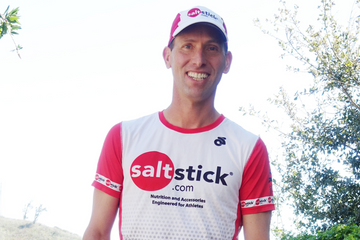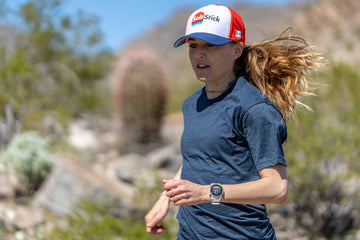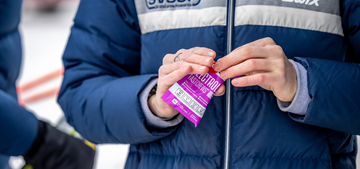
As told by SaltStick inventor Jonathan Toker, Ph.D.
It all began in mid-2002, as a long-distance professional triathlete habituated to the long-distance triathlon races; I grew weary of taping electrolyte capsules on my bike top tube. One race in particular, it was raining and my capsules turned to mush except the section under the electrical tape I used, and while I managed to finish that race with some salt in my system, I decided there had to be a better way to hold and dispense capsules.
I began to tinker with ideas of pen-like devices, but all had shortcomings and engineering issues. I was partial to a turning mechanism as I felt that an oxygen-deprived athlete should benefit from an easy-to-use system that was foolproof. Opening a sealed plastic bag from a jersey pocket was not ideal in so many respects that I further focused on the rotational design.
In mid-2003, I was discussing this issue with my coach at UCSD, Tom, inventor of the famed Titanflex bicycles, with my proposal for a tube full of capsules dispensed by rotation, but having some engineering problems. After talking to Tom during a workout, I had solidified some further ideas that were time to try on some hardware. During one particularly insightful moment on a bike ride, I suddenly came up with the idea of installing this dispenser inside bicycle bars- that was a leap beyond anything out there and suddenly made this idea very unique indeed.
With some concentric-size plastic syringes and other random parts, a hi-speed Dremel drill, and lots and lots of hot glue, I produced the first-ever prototype of what would become the "SaltStick" that was a proof-of-concept, but generally useless for the intended application.
This model, however, quickly became the basis for my USPTO document disclosure that acts as a 2-year bookmark for filing a patent application. This started a clock ticking, albeit a slow one. I also came up with the name – SaltStick® – one day as I mulled over the future of this project. I don’t know how it came about- the word just popped into my conscious thought- and it seemed to fit instantly. So there wasn’t a lot more work or effort in finding a name- it basically found itself and I just had to listen. Once I discovered the product name, I ran to reserve the corresponding website!
What was next? Many people have ideas; however going from idea to finished product is a long process with many engineering hurdles to overcome. This wasn’t my first idea that had potential value, but I felt strongly that it was worth pursuing further than my other ideas. Many months, contacts, and delays later, things moved forward.
My friends in the machine shop at alma mater Scripps steered me in the right direction with a local contact at a machine shop. My new friend John took a personal interest in this invention, and the very skilled Neil took this project (and quite some monetary commitment on my part) and generated the first working model that dispensed capsules! All this was made by hand in a machine shop.
Around this time, my good friend Jeff, a patent attorney, began to coach me on writing a patent, along with some excellent professional input, the provisional patent was professionally reviewed and filed, and that gave me a year to finalize the technology and utility.
The clock continued to tick. I began to shop around to some of the bicycle parts manufactures that I personally knew, aided by advice of Slowtwitch’s Dan and my friend Tom, both veterans of the multisport industry. Some where slightly interested, but the more I explored this avenue, the more I realized I would loose all control of the end result, and give up potentially something rather exciting. So I shifted my attention away from licensing the technology and returned to my roots as entrepreneur and moved forward on my own.
By this point, most of my friends were rather tired of hearing about this project… During this time, I began a business relationship with what I may consider the most important link in this story- a mould-maker in mainland China. The internet is an amazing resource of information, and I was able to obtain quotes and information from domestic and international sources. Some companies told me the design was too difficult to mould and they couldn’t do it. Others told me they could try, but not assure me of the result. Costs ranged from high to insanely high and this project looked like it might take some serious capital to move forward.
One company from China was interested in molding, but the English of the email was so fragmented, and they weren’t too keen to sign the NDA (non-disclosure agreement) because “it isn’t used anyway”. A bright light shone from one company, however, and they have since carried this project through the technical drawing stage involving significant engineering obstacles to sourcing various additional parts and packaging to the final product…but I’m getting ahead of myself here.
During the summer of 2005, I had considered moving forward with my 1st shop prototype to the production stage directly, but some good advice from friends encouraged me to spend another $1200 or so on additional prototype units- 25 SaltStick® dispensers (that’s $50+ each…not very profitable, if I could sell them!)- that would be used for engineering improvement and would be ready in time for Interbike 2005 in Las Vegas, and for use at the Ironman World Championships in Hawaii.
My friends at the machine shop in San Diego took on this task and made some changes based on athlete feedback and some new ideas I had. The result was a box of plastic bits that showed up at my door one day, the most expensive plastic bits I ever saw! I pretty much turned around and sent most of them off around the world to my athletic guinea pigs for testing. This is the 3rd in line in the photo below. I also expanded the product offering to include a mini model that was designed for road cycling bars- it had to be shorter to fit inside the smaller bar ends of road bikes, but my design was clever in that it was easy to adjust the length after manufacture by cutting off the unneeded portion before installing the end cap. The SaltStick® mini was born.
Over the past many years as a serious athlete, I’ve been very fortunate to have met, trained with, and become friends with some of the best and most dedicated amateur and professional multisport athletes from around the world. We all work really hard at training, and when you’re at the base of Mt. Palomar on Normann’s or Jurgen’s wheel sharing pulls, you’re all on equal (more or less…) footing. That’s one of the greatest aspects of this sport- that you really can train and race alongside with the figures you see in the magazines.
Of course, they would be my guinea pigs- and I am most appreciative of these friends and others for testing out these units, manufacturers at Interbike who took a personal interest in my project as I wandered the aisles, wearing my wandering salesperson hat. There were a lot of bright eyes and smiles as I shopped my SaltStick® around. Of course, I hadn’t sold a single one, yet, but I got a lot of encouragement and a newfound energy to push this project forward.
The SaltStick® caps came about during some conversations I had with friends- discussing the merits of electrolyte supplements in general, and the woeful lack of decent supplements out there. It’s not like there was not good science to support these concepts- mainstream media was even beginning to notice when a few people were dying after finishing marathons drinking only water. The capsule supplements available on the market all fall short in one way or another: too little sodium, no magnesium, etc… Or simply deliver too little to really be efficient, when you need 2 or more capsules per serving.
So I put my Ph.D. in chemistry to some good use, and I went about finding the basic electrolyte content of sweat (what leaves your body should be replenished in a quantity and form your body can use), bioavailable electrolyte sources, vegetarian capsules, field testing, and came up with the unique SaltStick® caps formulation as it stands today. With this formulation, athletes should need 1-2 capsules per hour instead of 3-10 capsules of other brands, and benefit from a much better profile of electrolytes. Plus, isn’t it great when you can offer a consumer something they need to replenish?
I’ve made the SaltStick® so that it should last for years, so I don’t expect many repeat sales for this reason alone…therefore the caps should complement this nicely. More details followed- trademark applications, business licenses, logo design, web design, etc…The list goes on and on- it just made me quick and adept at changing hats. Feedback from the Ironman World Championships 2005 in Kona was solid, and I made a few changes based on athlete suggestions- technical drawings were completed and approved (engineering hat) and mold-making began.
Injection molding is a conceptually simple process of injecting hot plastic in a metal void, cooling, and your part is made. But I’ve learned it is not nearly quite so simple in reality, and the guys in China have done an awesome job taking care of the details. Writing an instruction manual was a new experience as well, having to relate something that had become commonplace to me over the past few years to a new user was a challenge. I was helped though this challenge by some friends who graciously translated my words in Spanish (Maria), French (Louis), and German (Roger) in a compressed timeframe.
The package design came about with some initial tinkering on my part and some professional help, I am thrilled with the resulting package for both the SaltStick and SaltStick® mini. The label for the SaltStick® caps was artfully compiled by Jeff at the contract lab manufacturing the product. Navigating through the FDA regulations for food supplements was an experience unto itself. Finally, getting barcodes for all the products was a simple online matter, and a few more dollars.
The products have now moved away from the engineering and design phase and into the sales, marketing and support of the SaltStick® products, I reflect back on the non-linear path that I followed and realize that every aspect from conception of the idea to receipt of that first shipment from China has provided me with a mini-MBA.
On 4/17/07 US patent number 7,204,391 was issued.
The story continues…








